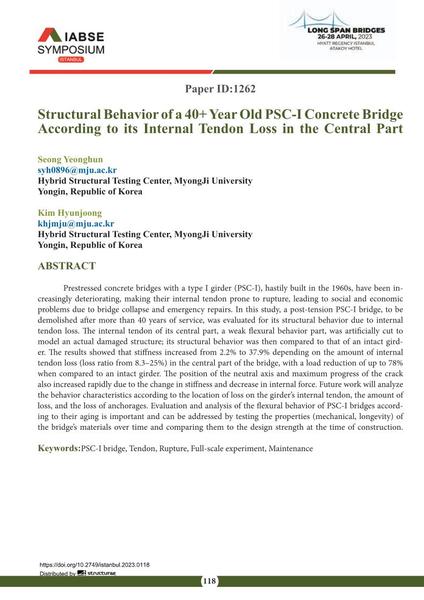Structural Behavior of a 40+ Year Old PSC-I Concrete Bridge According to its Internal Tendon Loss in the Central Part

|
|
|||||||||||
Bibliographic Details
| Author(s): |
Seong Yeonghun
(Hybrid Structural Testing Center, MyongJi University Yongin, Republic of Korea)
Kim Hyunjoong (Hybrid Structural Testing Center, MyongJi University Yongin, Republic of Korea) |
||||
|---|---|---|---|---|---|
| Medium: | conference paper | ||||
| Language(s): | English | ||||
| Conference: | IABSE Symposium: Long Span Bridges, Istanbul, Turkey, 26-28 April 2023 | ||||
| Published in: | IABSE Symposium Istanbul 2023 | ||||
|
|||||
| Page(s): | 118-125 | ||||
| Total no. of pages: | 8 | ||||
| Year: | 2023 | ||||
| DOI: | 10.2749/istanbul.2023.0118 | ||||
| Abstract: |
Prestressed concrete bridges with a type I girder (PSC-I), hastily built in the 1960s, have been increasingly deteriorating, making their internal tendon prone to rupture, leading to social and economic problems due to bridge collapse and emergency repairs. In this study, a post-tension PSC-I bridge, to be demolished after more than 40 years of service, was evaluated for its structural behavior due to internal tendon loss. The internal tendon of its central part, a weak flexural behavior part, was artificially cut to model an actual damaged structure; its structural behavior was then compared to that of an intact girder. The results showed that stiffness increased from 2.2% to 37.9% depending on the amount of internal tendon loss (loss ratio from 8.3–25%) in the central part of the bridge, with a load reduction of up to 78% when compared to an intact girder. The position of the neutral axis and maximum progress of the crack also increased rapidly due to the change in stiffness and decrease in internal force. Future work will analyze the behavior characteristics according to the location of loss on the girder’s internal tendon, the amount of loss, and the loss of anchorages. Evaluation and analysis of the flexural behavior of PSC-I bridges according to their aging is important and can be addressed by testing the properties (mechanical, longevity) of the bridge’s materials over time and comparing them to the design strength at the time of construction. |
||||
| Keywords: |
tendon maintenance full-scale experiment rupture Keywords:PSC-I bridge
|
||||
